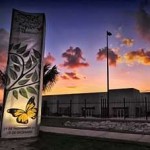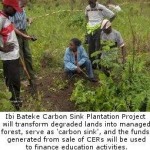Woods Hole, Massachusetts – In some cases, it can be difficult for scientists to see the deforestation for the trees.
Not so for Gillian Galford, a recent graduate of the Brown-MBL Graduate Program in Biological and Environmental Sciences (and now a post-doctoral fellow at Columbia University’s Earth Institute) and her colleagues, who take a big-picture approach to greenhouse gas emissions.
In a study published last week in ‘Proceedings of the National Academy of Sciences’, the team estimates future emissions of carbon dioxide, nitrous oxide, and methane in the Brazilian Amazon state of Mato Grosso, by combining 105 years of historical data on land-use changes with possible scenarios for future deforestation and land use in the region.

The results indicate that a recent pledge by the government of Mato Grosso to reduce deforestation rates by 89 percent by 2020 would be an effective way to minimize future greenhouse gas emissions.
“Our study shows not only that Mato Grosso can perhaps achieve this goal, but, if they stick with it, we now have an estimate of what their greenhouse gas emissions would be,” says Galford, who completed the research as part of her Ph.D. thesis for the Brown-MBL joint graduate program. “If they can adhere to their own goal, they are going to have much lower net emissions than they would if they followed the trajectory they were on.”
Galford and her colleagues considered two scenarios for future land-use change in Mato Grosso. In the business-as-usual scenario, deforestation and land-use changes occur at the same rapid rates associated with the early 21st century, when native forest and grasslands were being rapidly converted for agricultural uses. The governance scenario, which better reflects trends of the past few years, takes into account the state pledge to reduce deforestation. This scenario results in over 2 times lower greenhouse gas emissions estimated through 2050 (6.3 Pg CO2-e for the governance scenario, vs. 15.8 Pg CO2-e for the business as usual scenario, where Pg are Petagrams and CO2-e means carbon dioxide equivalents).
While previous models for future greenhouse emissions in the area have focused only on emissions resulting from deforestation, this is the first to also incorporate post-clearing land management by considering whether cleared land is used for crops or pasture. According to the study, the choice between crops and pasture can be significant for certain regions, but has little global effect.

Greenhouse gas emissions are of great concern in the Brazilian Amazon region. “This is one of the most dynamic places of changing land cover on the planet,” says John Mustard, a co-author of the study and Galford’s co-advisor in the Brown-MBL joint graduate program, along with Jerry Melillo of the MBL Ecosystems Center. “How does this affect carbon emissions now, and what does the future hold? Through observation and modeling we are now able to bring a strong focus to these questions,” Mustard says.
Galford says that the strategies used in this study could be used in other tropical regions to predict the results of land-use changes. “With this type of exercise you could analyze a few different scenarios to determine what the consequences for your greenhouse gas emissions would be,” she says.
Original Work:
Title of the Study: “Greenhouse Gas Emissions from Alternative Futures of Deforestation and Agricultural Management in the Southern Amazon”
Authors: Gillian L. Galford, Jerry M. Melillo, David W. Kicklighter, Timothy W. Cronin, Carlos E. P. Cerri, John F. Mustard and Carlos C. Cerri
Published online before print in Proceedings of the National Academy of Sciences (PNAS) on July 22, 2010, doi: 10.1073/pnas.1000780107
Click here to read the full study: http://www.pnas.org/content/early/2010/07/29/1000780107
About Marine Biological Laboratory (MBL)
The MBL is a leading international, independent, nonprofit institution dedicated to discovery and to improving the human condition through creative research and education in the biological, biomedical and environmental sciences. Founded in 1888 as the Marine Biological Laboratory, the MBL is the oldest private marine laboratory in the Americas. For more information, visit www.mbl.edu.
Source: MBL Press Release dated July 27, 2010.












